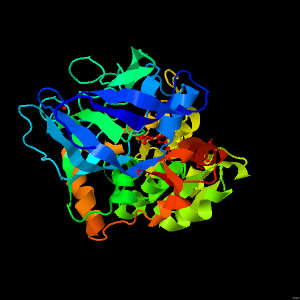Alcohol Dehydrogenase
Alcohol dehydrogenase catalyzes the oxidation of alcohols to produce aldehydes.
Each alcohol dehydrogenase monomer contains two domains, an NAD+ domain and a catalytic domain.
The NAD+ domain contains a six-stranded parallel beta sheet that is flanked by alpha helices on both sides.
The catalytic domain determines the events of catalysis and specificity of the substrate. This domain is a network of antiparallel beta sheets and also contains four helices.
A deep cleft separates these two domains. The substrate and the nicotinamide moiety of NAD+ fit in a deep pocket that lies within this cleft. Shown here is CNAD (5-beta-D-ribofuranosylnicotinamide adenine dinucleotide), an analog of NAD(H). CNAD is a potent competitive inhibitor of alcohol dehydrogenase.
The substrate binds in a pocket lined by numerous hydrophobic residues.
Each monomer also contains two zinc ions: the structural zinc ion and the catalytic zinc ion.
The structural zinc, located in a binding site distant from the active site, may play an important role in the folding of the enzyme. The structural zinc is coordinated by four Cys residues.
The catalytic zinc is located at the bottom of the active site pocket. It is coordinated by two Cys residues, a histidine residue, and the oxygen of the alcohol substrate.
When the coenzyme binds, a "hinge-like" conformational change occurs in the enzyme that closes the active site. This closure brings the substrate closer to the nicotinamide ring and brings the active site zinc ion closer to the coenzyme-binding domain. Ser48 and His51 participate in the alcohol proton abstraction and eventual release to the solvent.
The positive charges on the catalytic zinc ion and NAD+ stabilize the intermediate anion and thus facilitate hydride transfer.
CNAD binds to the catalytic zinc, blocking the zinc's coordination to the substrate. The substrate is displaced. Consequently Ser48 points away from the catalytic zinc. CNAD thus prevents hydride transfer and the appropriate abstraction of a substrate proton.
(for more information about alcohol dehydrogenase see this site at the Protein Data Base).
Prepared by Jackie Wilce, Monash University
Page skeleton and JavaScript generated by the Export to Web module of Jmol 14.29.29 on 04/01/2019.
